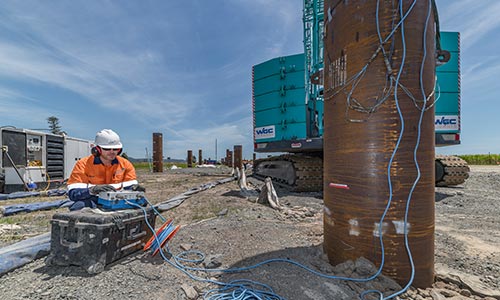
Introduction:
In the world of construction, innovation is the key to progress. One such innovation that is revolutionizing the way we approach foundation design and construction is dynamic pile load testing. This groundbreaking technique offers engineers and contractors valuable insights into the performance of deep foundations, helping to ensure the safety and integrity of structures in even the most challenging environments.
Understanding Dynamic Pile Load Testing
Dynamic pile load testing is a method used to assess the load-bearing capacity of deep foundation elements, such as piles and drilled shafts. Unlike traditional static load testing, which applies a static load to the foundation and measures its response, dynamic pile load testing involves applying a dynamic impact load to the foundation and analyzing its behavior in real-time and dynamic pile load test
The process typically involves striking the pile head with a heavy hammer or drop weight, causing a sudden impact that generates a stress wave propagating down the length of the pile. Sensors embedded in the pile measure the resulting force and velocity, allowing engineers to calculate the pile’s dynamic resistance and assess its load-bearing capacity.
Advantages of Dynamic Pile Load Testing
Dynamic pile load testing offers several advantages over traditional static load testing, making it a preferred method for assessing deep foundation performance:
Real-Time Results:
Dynamic testing provides immediate feedback on the pile’s behavior, allowing engineers to quickly assess its load-bearing capacity and make real-time adjustments to construction plans if necessary.
Cost-Effectiveness:
Dynamic testing can be completed more quickly and with fewer resources than static testing, reducing overall project costs and minimizing construction delays.
Non-Destructive Testing:
Unlike static load testing, which may cause permanent deformation or damage to the pile, dynamic testing is non-destructive, allowing the pile to remain intact for use in the final structure.
Ability to Test Multiple Piles:
Dynamic testing can be performed on multiple piles within a relatively short period, allowing engineers to gather comprehensive data on a foundation system’s performance.
Applications of Dynamic Pile Load Testing
Dynamic pile load testing is used in a wide range of construction projects, including:
- High-rise buildingsh
- Bridges and overpasses
- Industrial facilities
- Offshore structures
- Wind turbine foundations
- Transportation infrastructure
By providing valuable insights into foundation performance, dynamic pile load testing helps engineers design safer, more efficient structures that can withstand the challenges of their environment.
Case Study: Dynamic Pile Load Testing in High-Rise Construction
To illustrate the effectiveness of dynamic pile load testing, let’s consider a hypothetical case study involving the construction of a high-rise building in a seismic zone. The project involves driving large-diameter piles deep into the ground to support the weight of the structure and resist lateral forces during an earthquake.
Before proceeding with pile installation, engineers conduct dynamic pile load testing to assess the capacity of the piles and ensure they meet the project’s design requirements. Using specialized equipment and instrumentation, they strike each pile with a series of dynamic impacts and measure its response to varying load levels.
The test results reveal valuable insights into the pile
js’ behavior, including their dynamic resistance, bearing capacity, and integrity. Engineers use this data to fine-tune the design of the foundation system, optimizing pile spacing, length, and configuration to maximize structural performance and safety.
Conclusion
Dynamic pile load testing is a powerful tool that is driving innovation in the construction industry. By providing real-time insights into foundation performance, this groundbreaking technique helps engineers design safer, more efficient structures that can withstand the rigors of their environment.
As construction projects become increasingly complex and demanding, dynamic pile load testing offers a cost-effective, non-destructive solution for assessing deep foundation performance and ensuring the success of critical infrastructure projects around the world.
Incorporating dynamic pile load testing into construction projects can help engineers and contractors build with confidence, knowing that their foundations have been rigorously tested and proven to meet the highest standards of safety and reliability.




